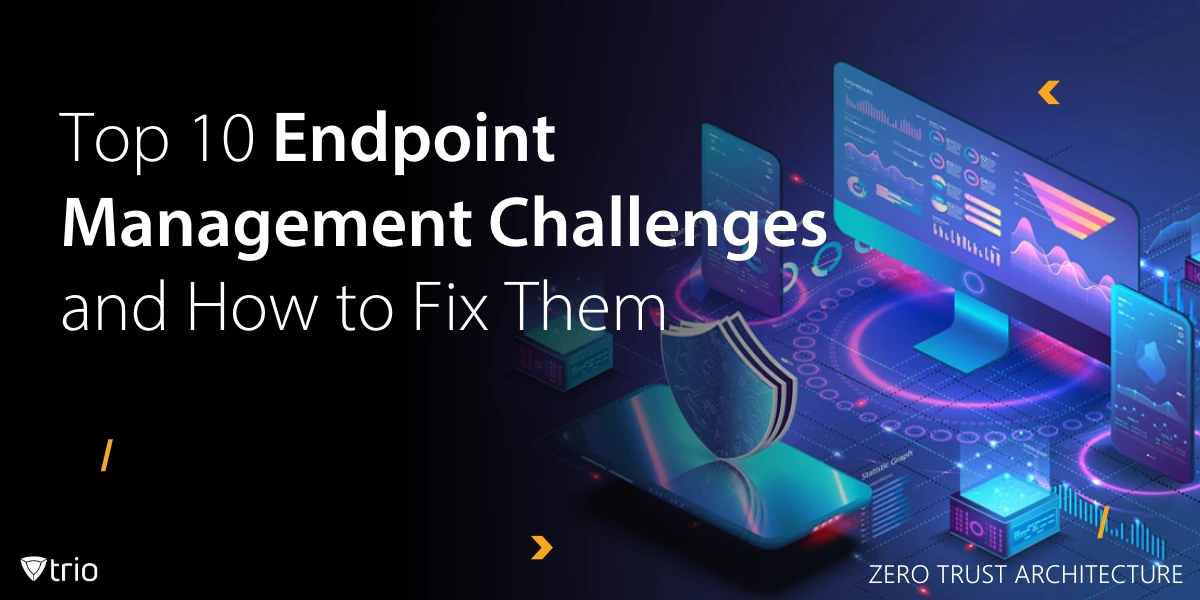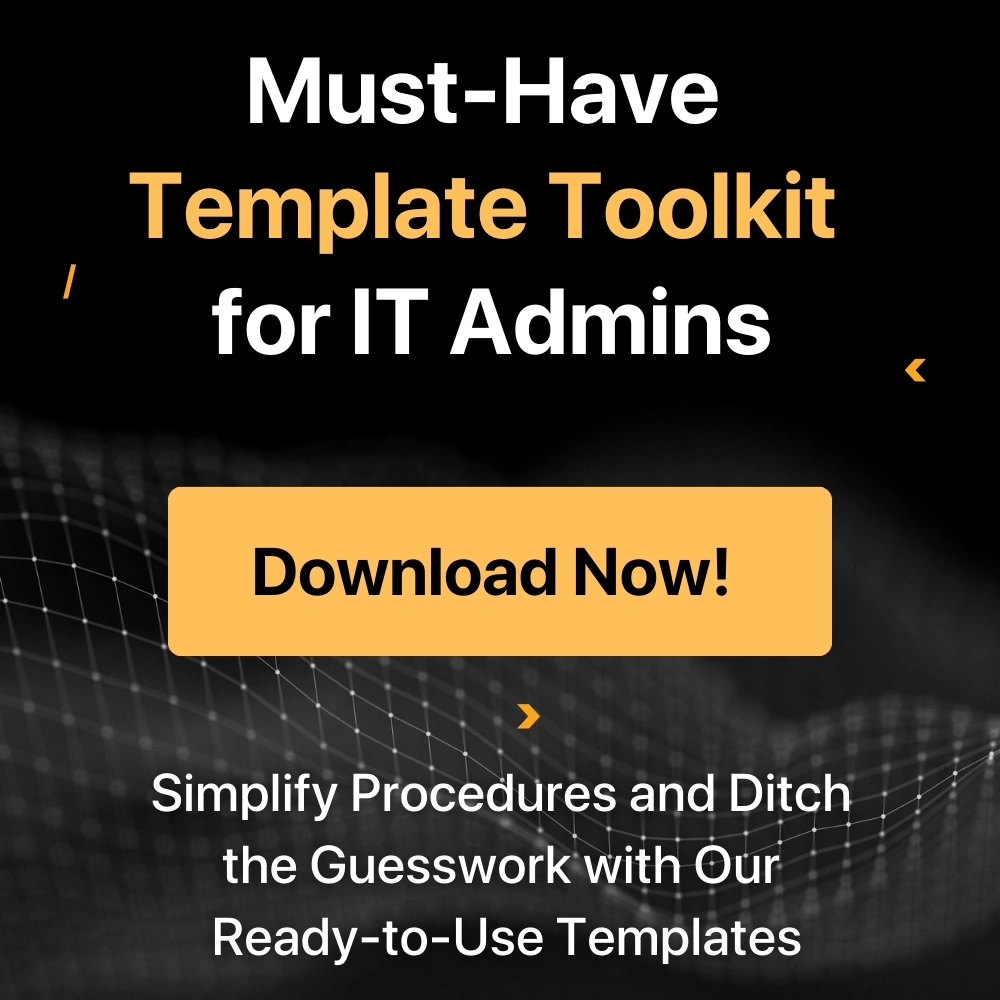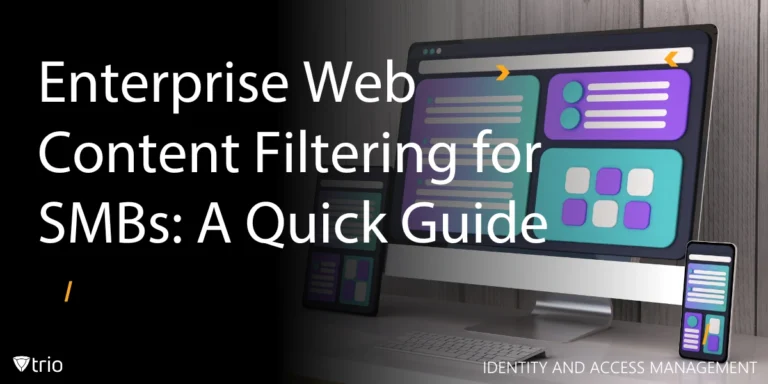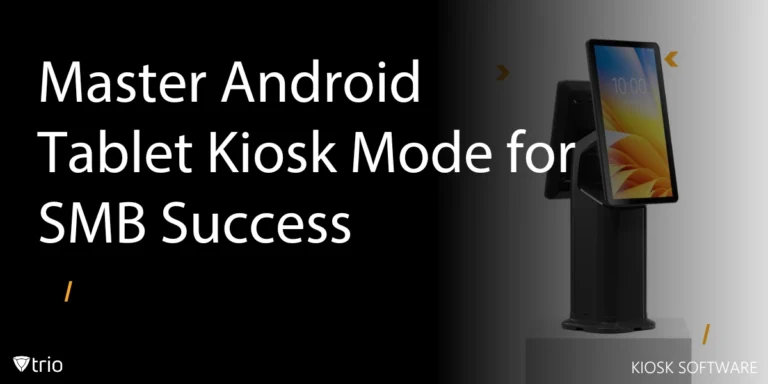In an era of distributed workforces and Bring-Your-Own-Device (BYOD) policies, endpoint management has become one of the toughest puzzles CIOs and IT leaders face. Picture endpoint management challenge: your organization has 200 employees, each working from home on personal laptops, tablets, and smartphones. Some connect via home Wi-Fi, others on public networks. A handful haven’t “phoned home” to corporate systems in weeks.
Do you know:
- Which applications are installed on every device?
- Which operating systems are overdue for patching?
- Which endpoints have slipped out of your visibility?
If the answer isn’t a confident “Yes,” you’re not alone. Recent industry data shows nine out of ten companies struggle to maintain full control over their endpoint fleets. Left unchecked, unmanaged devices become prime targets for cyberattacks, compliance violations, and service disruptions.
This comprehensive guide will:
- Unpack ten critical challenges—from device sprawl to scale—and show you how to tackle each one.
- Demonstrate how a cloud-native, zero-trust platform, such as TrioMDM, maps directly to these challenges, closing gaps and streamlining your security posture.
- Introduce new topics—like IoT device sprawl, ITSM integration, and AI-driven threat detection.
- Offer practical next steps and a vendor evaluation checklist.
By the end, you’ll have a 360° playbook to transform endpoint chaos into a fortified, automated environment—without drowning in manual tasks.
Challenge #1: Device Proliferation & Fragmentation
The Problem
Your fleet no longer looks like a uniform lineup of corporate laptops. Instead, it’s a cacophony of personal devices, varying OS versions, and unmanaged hardware. Fragmentation breeds insecurity: inconsistent policies, patch gaps, and unsupported configurations.
Why It’s Critical
- Inconsistent enforcement leaves loopholes attackers exploit.
- Manual tracking strains IT resources and leads to human error.
- BYOD ambiguity heightens privacy and liability concerns.
Best Practices
- Standardize on a core set of supported OS versions; sunset legacy releases.
- Enforce a corporate image or container for BYOD scenarios.
- Regularly audit device types and total counts; retire or isolate unsupported hardware.
Challenge #2: Security Threats & Vulnerabilities
The Problem
Endpoints are the front door for 75-plus percent of breaches. Missing patches, disabled AV, unmonitored USB ports, or outdated browsers—all create low-hanging fruit for attackers.
Why It’s Critical
- Attackers pivot from an infected laptop to domain admins in under 24 hours.
- Ransomware often lurks behind unpatched, forgotten machines.
Best Practices
- Implement MFA on device logins and critical apps.
- Enforce disk encryption at boot time.
- Run regular vulnerability scans and adapt patch schedules based on severity.
How a modern solution addresses this (e.g., TrioMDM):
- Automated Patch Orchestration: Such solutions can schedule OS and application updates across time zones; retry on failure.
- Self-Healing Agents: If a security agent is disabled or tampered with, a robust endpoint management platform can automatically reinstall and re-configure it. (coming soon feature)
- Zero-Trust Posture Checks: These systems can block access if encryption is off, AV definitions are outdated, or unapproved software is detected.
Challenge #3: Compliance & Regulatory Headaches
The Problem
GDPR, HIPAA, CCPA, SOX, PCI-DSS, SOC 2—all demand stringent controls, audit logs, and breach notifications. Personal devices and remote endpoints often escape standard audits.
Why It’s Critical
- Fines can exceed millions of dollars per violation.
- Compliance officers require evidence of policy enforcement at all times.
Best Practices
- Map policies to regulations (e.g., encryption = GDPR; MFA = PCI-DSS).
- Schedule quarterly compliance drills and report findings to leadership.
- Train end-users on data-handling guidelines as part of onboarding.
How a modern solution addresses this (e.g., TrioMDM):
- Compliance Automation: You can define policies as code, and a UEM platform can continuously audit and enforce them.
- Audit-Ready Reporting: Solutions can generate on-demand reports showing which devices met encryption, patch, and configuration baselines.
- Selective Wipe: Upon offboarding, these platforms allow you to wipe only corporate containers, leaving personal data untouched.
Challenge #4: Visibility & Control Gaps
The Problem
Shadow IT runs rampant when employees install unauthorized apps or connect unapproved devices. Incomplete inventories and stale spreadsheets hide these risks.
Why It’s Critical
- Delayed discovery of compromised endpoints magnifies breach impact.
- IT can’t remediate what it can’t see—and response times suffer.
Best Practices
- Integrate endpoint telemetry into your SIEM or ITSM system.
- Enable geofencing to detect anomalous login locations.
- Set up automated alerts for devices missing check-ins beyond your policy threshold (e.g., 48 hours).
How a modern solution addresses this (e.g., TrioMDM):
- Real-Time Inventory: Every device check-in reports hardware, OS, installed apps, and user context.
- Live Dashboards: See compliance drift, patch status, and security alerts at a glance.
- Automated Remediation: Quarantine or restrict network access for offline or non-compliant devices.
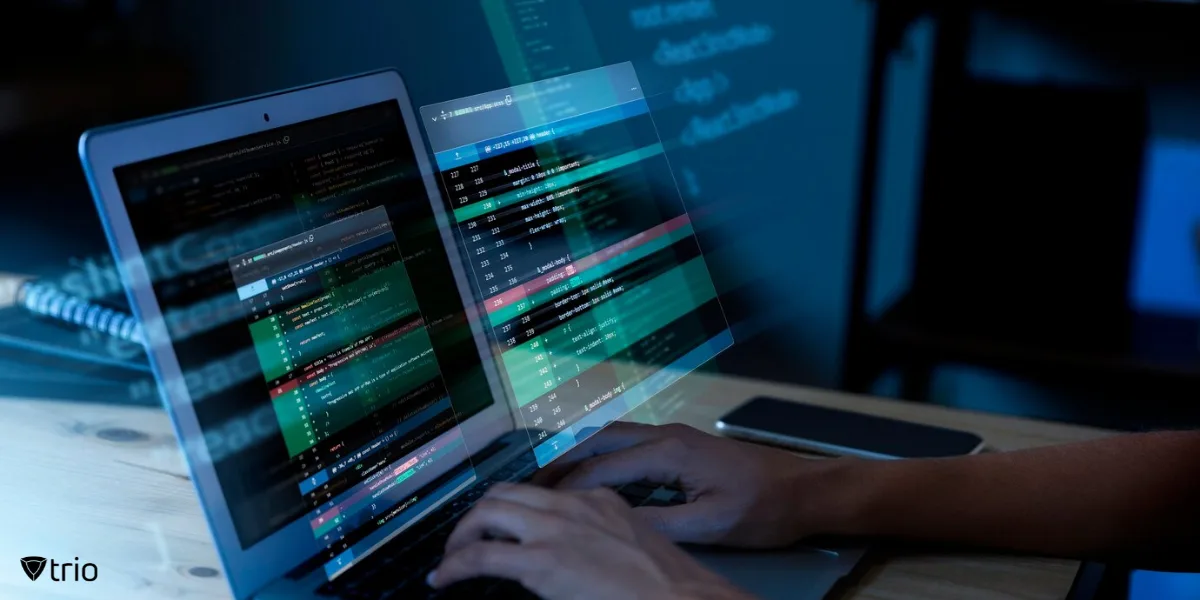
Challenge #5: Remote & Hybrid Work Complexities
The Problem
Home networks and public Wi-Fi lack enterprise-grade security. Traditional VPNs or RD Gateways become chokepoints and single points of failure.
Why It’s Critical
- Frustrated users bypass VPNs, opting for shadow-IT file-sharing services.
- Misconfigured remote-access platforms expose corporate assets to the public Internet.
Best Practices
- Move toward cloud-native remote-access services that integrate with your UEM.
- Enforce contextual controls—device health, location, time of day—before granting access.
- Monitor remote sessions for anomalous behavior (e.g., lateral scans, privilege escalations).
Duo of Solutions
- Hardened Remote Desktop Gateway
- Complex Setup: Requires certificates, firewall NAT rules, load balancers, and strict authorization policies.
- Integration with UEM: Solutions like TrioMDM can distribute and renew certificates automatically; enforce gateway-only connections from compliant endpoints.
- Zero-Trust Network Access (ZTNA)
- Beyond VPN: Brokers RDP, SSH, and web app access over TLS—no full-tunnel, no DMZ exposure.
- Integration with UEM: Platforms like TrioMDM can enforce device posture before granting access to any application; revoke sessions instantly on drift.
Challenge #6: Patch Management & Software Updates
The Problem
Unpatched endpoints remain vulnerable for weeks or months—an open invitation for ransomware gangs who exploit known CVEs.
Why It’s Critical
- A 2021 study found over half of ransomware infections exploited vulnerabilities older than two years.
- User deferrals, offline laptops, and complex patch matrices slow rollouts.
Best Practices
- Automate patch approvals based on risk scoring.
- Leverage pilot groups to catch compatibility issues before mass deployment.
- Provide self-service patch portals so power users can fetch updates without IT tickets.
How a modern solution addresses this (e.g., TrioMDM):
- Universal Patch Engine: Support for Windows, macOS, Linux, and third-party applications is a common feature.
- SLA-Driven Rollouts: You can define critical vs. noncritical patches; push high-risk fixes within 48 hours, schedule others in maintenance windows.
- Roll-Back Capability: If a patch causes issues, some platforms can automatically revert to the last known good state.
Challenge #7: Scalability & Cost Control
The Problem
As endpoint counts grow, per-device licensing, fragmented tooling (MDM + EDR + patch manager + compliance module), and manual tasks drive budgets skyward.
Why It’s Critical
- Multiple point solutions multiply complexity and cost.
- Headcount requirements climb if you rely on manual processes.
Best Practices
- Consolidate on a modular platform rather than siloed point tools.
- Automate as many routine tasks as possible to free up IT staff.
- Negotiate volume discounts or enterprise agreements based on forecasted device growth.
How a modern solution addresses this (e.g., TrioMDM):
- All-in-One Platform: Some solutions aim to provide MDM, UEM, EDR, patching, and compliance in a single console.
- Flexible Licensing: Look for unlimited devices or modular add-ons to match your scale.
- Task Automation: Features often include provisioning, de-provisioning, reporting, and remediation via workflow engines.
Challenge #8: User Training & Security Awareness
The Problem
Even the strongest technical controls falter if users click malicious links or ignore update prompts.
Why It’s Critical
- Social engineering remains the top attack vector—humans are the weakest link.
- Shadow-IT arises when employees feel policies are too restrictive.
Best Practices
- Run quarterly phishing drills and measure click rates.
- Incorporate policy acknowledgments into the login flow.
- Reward secure behavior (e.g., badge for teams with zero policy violations).
How a modern solution addresses this (e.g., TrioMDM):
- Embedded Micro-Learning: Some platforms can deliver short security tips and policy reminders during endpoint check-in.
- Phishing Simulation: Solutions can test user readiness and automatically escalate retraining for those who click.
- Self-Service Portal: Empower users to install approved software, reset passwords, and view policy status without tickets.
Challenge #9: IoT & OT Device Sprawl
The Problem
Industrial sensors, meeting-room displays, smart HVAC controllers—IoT devices often ship with weak credentials and no standard agent for management.
Why It’s Critical
- Compromised IoT can serve as footholds into critical networks or exfiltrate sensitive data.
- Lack of inventory and patch channels makes them persistent blind spots.
Best Practices
- Maintain an IoT asset registry and segment them on isolated VLANs.
- Implement network access control (NAC) that enforces device attestation.
- Where possible, push firmware updates via centralized services or orchestrate vendor-provided patch tools.
How a modern solution addresses this (e.g., TrioMDM):
- Network Discovery: Look for passive scanning capabilities to identify unknown IP-based devices.
- Certificate & Key Distribution: Some platforms automate TLS cert provisioning for devices that support custom firmware.
- Micro-Segmentation: Enforce network policies at the switch/router level based on device identity.
Challenge #10: ITSM & Workflow Integration
The Problem
Endpoint alerts multiply quickly—patch failures, posture drifts, compliance violations. Without ITSM integration, tickets pile up and SLAs slip.
Why It’s Critical
- Manual ticket creation wastes time and introduces errors.
- Lack of context (device history, user role) hampers fast resolution.
Best Practices
- Define alert-to-ticket mappings and thresholds to avoid ticket storms.
- Use chatops—integrate with Slack or Teams for on-demand remediation commands.
- Track MTTR and tune alert rules to balance noise vs. coverage.
How a modern solution addresses this (e.g., TrioMDM):
- Bi-Directional Integration: Solutions can create, update, and close tickets in ServiceNow, Jira, or Zendesk directly from their alerts.
- Context-Rich Tickets: Platforms can automatically attach device metadata—OS, patch status, last check-in—to each incident.
- Automated Remediation Workflows: This can triage low-risk drifts (e.g., missing antivirus definitions) without human intervention.
Additional Section: Key Metrics & KPIs
To prove ROI and continually refine your strategy, track:
- Mean Time to Patch (MTTP) for critical vs. non-critical CVEs.
- Compliance Pass Rate: Percentage of endpoints meeting policy baselines at any given moment.
- Incident Response Time (IRT) from detection to containment.
- Ticket Volume Reduction after automation roll-outs.
- User Satisfaction Scores for your self-service portal.
Many UEM platforms, including TrioMDM, offer built-in dashboards and customizable reports to make these metrics visible to both IT and executive teams.
Vendor Evaluation Checklist
When selecting or renewing an endpoint management solution, ensure your shortlist meets these criteria:
- Unified Platform: MDM, UEM, EDR, patching, compliance in one console.
- Cloud-Native & Agentless: Minimal on-prem infrastructure; agentless enrollment where possible.
- Zero-Trust Posture Enforcement: Conditional access based on device health and user context.
- Automation & Remediation: Self-healing, patch orchestration, policy drift correction.
- ITSM & SIEM Integration: Bi-directional ticketing and alert streaming.
- Scalability & Licensing: Flexible pricing that scales with your footprint.
- IoT & OT Support: Discovery, segmentation, firmware update orchestration.
- User Engagement: Self-service portals, micro-learning, phishing simulations.
- Reporting & Compliance: Audit-ready exports and dashboards mapped to regulations.
- Future-Proof: Roadmap for AI-driven threat detection, conditional access, and deeper analytics.
Emerging Trends: AI & Machine Learning
- Anomaly Detection: ML models that learn normal device behavior—flag deviations like unusual process launches or lateral movement.
- Predictive Patching: Algorithms that forecast which CVEs pose the highest risk to your environment, helping you prioritize.
- Automated Playbooks: AI-driven workflows that triage incidents end-to-end—no manual intervention required.
Leading solutions in the market, including TrioMDM, are already investing in these capabilities: early adopters can pilot AI-based threat hunting modules and risk-scoring engines integrated directly into their dashboards.
Case Study Snapshot
An IT company had 1,500 remote endpoints, 40% BYOD, and a patch lag of 30+ days. After implementing a comprehensive endpoint management solution (e.g., TrioMDM):
- Patch lag dropped to under 7 days.
- Compliance across GDPR baselines rose from 65% to 98%.
- Ticket volume for patch failures fell by 70%.
- MTTR for critical incidents improved by 55%.
Their IT director calls it “the single biggest efficiency boost we’ve had in five years.”
Next Steps for Your Team
- Audit your current endpoint estate—use discovery tools or enable a solution's passive scanning.
- Pilot core modules: enrollment, patch orchestration, compliance automation, and zero-trust posture.
- Roll out user training and self-service portals to reduce ticket volume.
- Integrate with ITSM and SIEM for end-to-end visibility.
- Measure success via MTTP, compliance pass rates, and cost savings.
Final Thoughts
Endpoint management is no longer a checkbox exercise. It’s the foundation of security, compliance, and operational excellence in a world where edges extend far beyond the office. By adopting a unified, cloud-native, zero-trust approach—anchored by automation and AI—you can turn your endpoint fleet from an unmanaged risk into a strategic asset.
A solution like TrioMDM is designed to deliver that approach today: seamless enrollment, policy enforcement, self-healing posture checks, remote remediation, detailed analytics, and a roadmap for AI-powered threat defense. If you’re ready to eliminate blind spots and empower your IT team to focus on high-value initiatives, scheduling a demo with TrioMDM (or a similar leading platform) can help you see the future of endpoint management in action.
Ready to Transform Your Endpoint Management?
Don’t let unmanaged devices put your organization at risk. Experience the power of unified, cloud-native endpoint management with a personalized demo of TrioMDM—complete with agentless enrollment, zero-trust posture checks, automated patching, and compliance automation.
Schedule your free demo today and see how you can lock down every endpoint, streamline operations, and reclaim hours of your IT team’s time.
Take control now—your secure, automated future starts here.
Frequently Asked Questions
Managing endpoints in today's complex IT environments is no small feat. Organizations face a range of persistent challenges that go beyond routine technical tasks, affecting everything from security posture to regulatory compliance. In this FAQ section, we address the most common concerns and questions around endpoint management, offering practical insights and solutions to help you stay ahead of the curve.
Q1: What’s the difference between MDM, UEM, and EDR?
- MDM (Mobile Device Management) focuses on mobile OS enrollment, basic policy pushes, and app catalogs.
- UEM (Unified Endpoint Management) extends that to laptops, desktops, IoT, and virtual endpoints—consolidating config, patching, and compliance.
- EDR (Endpoint Detection & Response) adds active threat hunting, behavioral analysis, and automated isolation. Some advanced platforms, like TrioMDM, aim to merge all three.
Q2: How do I secure personal devices without infringing on privacy?
Use containerization: corporate apps and data live in a sandbox, while personal files remain untouched. Combine that with selective wipe on offboarding and a clear BYOD policy.
Q3: Can cloud-native remote access truly replace VPNs?
Yes—Zero-Trust Network Access (ZTNA) and cloud RDP brokers enforce per-app, per-session policies without full-tunnel VPN exposure. Leading UEM solutions, for instance TrioMDM, integrate posture checks directly into these services.
Q4: What KPIs should my board care about?
Focus on MTTP (Mean Time to Patch), MTTR (Mean Time to Remediate), Compliance Pass Rate, Ticket Volume Reduction, and TCO savings from tool consolidation.
Q5: What’s next in endpoint management?
Expect deeper AI/ML integration—predictive patching, anomaly detection, and autonomous playbooks that resolve incidents without human intervention. Platforms like TrioMDM have roadmaps that include these features, giving you a clear path forward.
Get Ahead of the Curve
Every organization today needs a solution to automate time-consuming tasks and strengthen security.
Without the right tools, manual processes drain resources and leave gaps in protection. Trio MDM is designed to solve this problem, automating key tasks, boosting security, and ensuring compliance with ease.
Don't let inefficiencies hold you back. Learn how Trio MDM can revolutionize your IT operations or request a free trial today!
